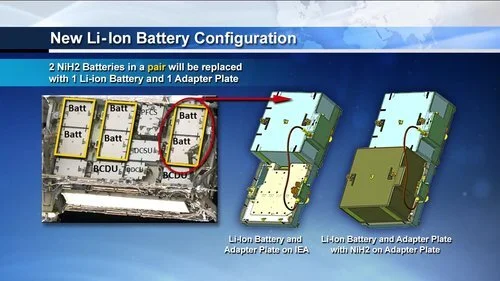Astronauts finish replacing batteries on port side of ISS
/Three months after the first all-female spacewalk, NASA astronauts Christina Koch and Jessica Meir ventured outside the International Space Station twice in five days to complete work replacing batteries, helping to set the stage for the next decade of ISS operations.
Two spacewalks — U.S. EVA-62 and U.S. EVA-63 on Jan. 15 and Jan. 20, respectively — saw the astronaut duo install the last three lithium-ion batteries on the 4B power channel on the P6 truss segment. This replaced six older nickel-hydrogen batteries, which were stowed on a nearby external pallet for eventual disposal.
U.S. EVA-62 animation. Credit: NASA
“Our heartfelt thanks goes to everybody down there on the NASA team for their efforts in making today’s spacewalk and this entire space station battery upgrade series successful,” Koch said at the end of U.S. EVA-63. “Much thanks to Luca [Parmitano] and Drew [Morgan] as well for getting us out and back in safely. This has really been an amazing experience being part of this Expedition 61 EVA team.”
These external batteries aren’t your typical household charging devices. Each of the lithium-ion units are about the size of a small refrigerator and have a mass of 200 kilograms.
Six new batteries were brought to the ISS in September 2019 aboard the Japanese Kounotori 8 spacecraft. The goal was to replace batteries on the 2A and 2B power channels.
The initial two spacewalks were performed in October and focused on the 2A channel. However, a problem with a charge-discharge unit on the same power channel prompted an indefinite postponement while Koch and Meir replaced the failed device.
On the ground, NASA teams wanted to understand the failure before moving ahead with further replacements.
In the meantime, two other astronauts — NASA’s Drew Morgan and the European Space Agency’s Luca Parmitano — performed three spacewalks to repair the Alpha Magnetic Spectrometer in late November and early December. That repair series still has one outing remaining, which is scheduled for Jan. 25 and will also be performed by Morgan and Parmitano.
Overall, 12 nickel-hydrogen batteries were replaced by six more-efficient lithium-ion batteries. The process involved moving the batteries from the pallet to the work area by passing them back and forth. Normally, the robotic arm would have performed this work. However, the location is just out of reach of the 17.6-meter-long robotic device.
As each lithium-ion battery was replacing two nickel-hydrogen units, a battery adapter plated need to be installed next to each newer unit to complete the circuit. These plates also doubled as a storage location for several nickel-hydrogen batteries, which cannot fit on the storage pallet (it can only hold up to nine).
This was the third spacewalk series dedicated to replacing the outpost’s old nickel-hydrogen batteries. The first two sets occurred in January 2017 and March 2019 and both included two EVAs focusing on the S4 and P4 truss segments, respectively.
A final series is planned for later this year when the Kounotori 9 spacecraft launches from Japan. That flight is currently expected no earlier than May 2020.
U.S. EVA-62 lasted 7 hours, 29 minutes. U.S. EVA-63 lasted 6 hours, 58 minutes. Both started around 11:35 UTC on Jan. 15 and Jan. 20, respectively. They were the 225th and 226th spacewalks in ISS program history, bringing the total time spent outside by astronauts and cosmonauts to 59 days, 6 hours and 10 minutes.
This was the 8th of 9 planned spacewalks for Expedition 61, the most for any space station expedition.
These last two spacewalks are expected to be the final for Koch and Meir before they return to Earth aboard their respective Soyuz spacecraft. Koch now has six outings under her belt for a total of 42 hours, 15 minutes, while Meir has three for a total of 21 hours, 44 minutes.
Koch is slated to return aboard Soyuz MS-13 on Feb. 6, 2020, along with Parmitano and Russian cosmonaut Aleksandr Skvortsov. Sometime in April, Meir is expected to return in Soyuz MS-15 with Morgan and Russian cosmonaut Oleg Skripochka.
Upon her return, Koch will have accumulated more than 328 days in space. This is the longest single spaceflight by a woman and fifth longest overall. She’ll only be 12 days short of beating NASA astronaut Scott Kelly’s record for the longest American spaceflight.
Soyuz MS-13’s February departure will officially end Expedition 61 and start Expedition 62, which itself will end with the departure of Soyuz MS-15 in April.
Between those departures. Another three-person crew is expected to fly to the outpost aboard Soyuz MS-16. NASA astronaut Chris Cassidy and Russian cosmonauts Nikolai Tikhonov and Andrei Babkin are lated to launch no earlier than April 9, 2020.
Upon the departure of Soyuz MS-15, Cassidy, Tikhonov and Babkin will form the primary crew for Expedition 63. Exactly how long they will remain a three-person crew is currently unclear. However, they are expected to be joined by one or more Commercial Crew Program vehicles on their piloted test missions.
SpaceX’s Demo-2 mission, with NASA astronauts Bob Behnken and Doug Hurley, are expected to fly to the ISS in the second quarter of 2020. As of right now, it is unknown if their mission will be a short-duration flight or a multi-month flight.
Meanwhile, Boeing’s CST-100 Starliner is also expected to perform it’s first crewed flight sometime in the first half of 2020. That mission will see NASA astronauts Michael Fincke and Nicole Mann, along with Boeing astronaut (and former NASA astronaut) Chris Ferguson, fly to the outpost for several months.







